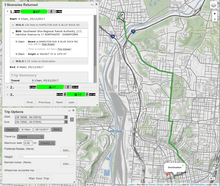Public transport route planner

A public transport route planner is an intermodal journey planner, typically accessed via the web that provides information about available public transport services. The application prompts a user to input an origin and a destination, and then uses algorithms to find a good route between the two on public transit services. Time of travel may be constrained to either time of departure or arrival and other routing preferences may be specified as well.
An intermodal journey planner supports intermodal journeys i.e. using more than one modes of transport, such as cycling, rapid transit, bus, ferry, etc. Many route planners support door-to-door planning while others only work between stops on the transport network, such as stations, airports or bus stops.
History
One of the first digital public transport journey planner software was developed by Eduard Tulp, a informatica student at the Amsterdam University on a Atari PC.[1] He was hired by the Dutch Railways to built a digital journey planner for the train services. In 1990 the first digital journey planner for the Dutch Railways (on diskette) was sold to be installed on PC´s and computers for off-line consultation.[2] The principles of his software program was published in a Dutch university paper in 1991[3] This was soon expanded to include all public transport in the Netherlands.
Another pioneer was Hans-Jakob Tobler in Switzerland. His product Finajour, which ran for PC DOS and MS-DOS was the first electronic timetable for Switzerland. The first published version was sold for the timetable period 1989/1990.[4][5][6]
Other European countries soon followed with their own journey planners.
Data exchange standards
For transit route planners to work, transit schedule data must always be kept up to date. To facilitate data exchange and interoperability between different trip planners, several standard data formats have emerged.
The General Transit Feed Specification, developed in 2006,[7] is now used by hundreds of transit agencies around the world.
In the European Union all public passenger travel operators have the obligation to provide the information under the EU railway timetable data exchange format.[8][9][10] In other parts of the world there similar exchange standards.[11]
Notable examples
References
- ↑ Trouw, 05/06/1998
- ↑ "175 years of travel information, chapter:Wel of geen vervoer?" (in (in Dutch)). 9292.nl. 1992-09-02. Retrieved 2018-10-03.
- ↑ http://kinkrsoftware.nl/contrib/Artikel16b.2a/tulp.pdf, Tulp, Eduard, Searching time-table networks, proefschrift Vrije Universiteit Amsterdam, 1991
- ↑ Tages-Anzeiger, 14 February 2009, p. 14, Hans-Jakob Tobler gestorben. Source: Argus Medienbeobachtung (through archive.org) (PDF file; 70 kB).
- ↑ Alexandria. Entry Finajour 1.02 Sommer 1989.
- ↑ Computerwoche: Schweiz: Fahrpläne im Videotex, 22 September 1989 («Schon auf den Fahrplanwechsel in diesem Frühjahr war die PC-Version des schweizerischen Zugfahrplans von der Firma Finajour veröffentlicht worden. Inzwischen wurden gut tausend Exemplare zu einem Stückpreis von hundert Franken verkauft.»)
- ↑ "Pioneering Open Data Standards: The GTFS Story". beyondtransparency.org. Retrieved 2017-05-10.
- ↑ "NeTEx". Netex-cen.eu. 2014-03-18. Retrieved 2018-10-03.
- ↑ "SOA architecture for complying with EU railway timetable data exchange format (link in chapter Präsentationen)". Ieeexplore.ieee.org. Retrieved 2018-10-03.
- ↑ "Transnational exchange of timetable and GIS data as a basis for cross-border ITS services". Gip.gv.at. Retrieved 2018-10-03.
- ↑ "Transit Schedule Data Exchange Architecture". Google.nl. Retrieved 2018-10-03.